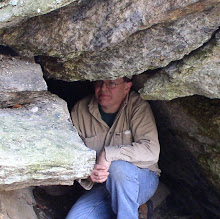Time once again to visit the northeast portions of the Bay State. I used the traditional methods of way in/way out, which simply means catching some locations during the travels to and from my ultimate destination.
The memorial boulder to Asa Pollard
The first day brought me into Billerica where I quickly located the Asa Pollard memorial boulder. Asa was the first person killed at the Battle of Bunker Hill and the rock rest by the roadside, out in front of his old homestead site. Another stop at Gilson Hill, brought me to a suspected Indian (grindstone) rock which is informally known as the Rowell Memorial Stone. Numerous erratics dot the surrounding forest including a large one at a lower level, northeast from the summit.
The 'upper' - or Tower Cave 1
Moving deeper into the urban environment, an erratic of significant size was located down near Horn Pond in Woburn. From there, it was just a short jaunt over to the east to check in at Melrose. Visited here were Cleft Boulder/Chapel Rock, the Great Stone Face, Dwyer Cave site (presumably destroyed), and the Tower Caves, which are most likely over the town line in Essex. From here it was only to brave the city traffic to make my way up to Cape Ann.
The Ralph Waldo Emerson tablet - from an early 1900's postcard
Nothing significant was planned for this visit to the Cape. I made use of the time to relax and putter about. On the morning of day two, I dropped in to the rocks at Pigeon Cove. A long shot, but once a plaque existed somewhere on the rocks as a memorial to Ralph Waldo Emerson. Unfortunately, the plaque has not been seen in ages and its exact location unknown. But I used the opportunity to make my way south back to the Inn that bears the name of Emerson, looking over all my favorite old spots from years past: Frog Rock, Dick's Dream, Meteor Rock, the Great Gargoyle, Chapin's Gully, Pulpit/Singer's Rock, and others. A quick look at the Granite Pier proved it was once again usable (previous coated with horribly slick algae) for future kayak trips. Then brief visits to Lanes Cove, Poles Hill access, Red Rocks and other Essex County Greenbelt lands in that vicinity.
Pulpit Rock - from an early 1900's postcard
Day three brought me down to another old favorite: Lynn Woods Reservation. Over the years this location has provided much enjoyment and MANY rocks! I continued explorations both north of Walden Pond then to its south. A number of impressive boulders were seen, measured, photographed and catalogued.
The 18' high Goliath Boulder
The final day was scheduled to be an 'iffy' weather day. But the rains held off and the morning brought me down to Acton. After having Egg Rock in my notes for many years, I finally got to see it! Then just a quick jump to a nearby section of town to visit a 'cave' shown to me by Dan Boudillion many years ago. Sometimes know as Potato or Indian Cave, it is actually a stone chamber which has been nicely restored in recent years.
The Nashoba Brook stone chamber entrance
Completing my tasks in Acton, it was only to turn towards Rt 495, then down to the Mohawk Trail for my return home.






































